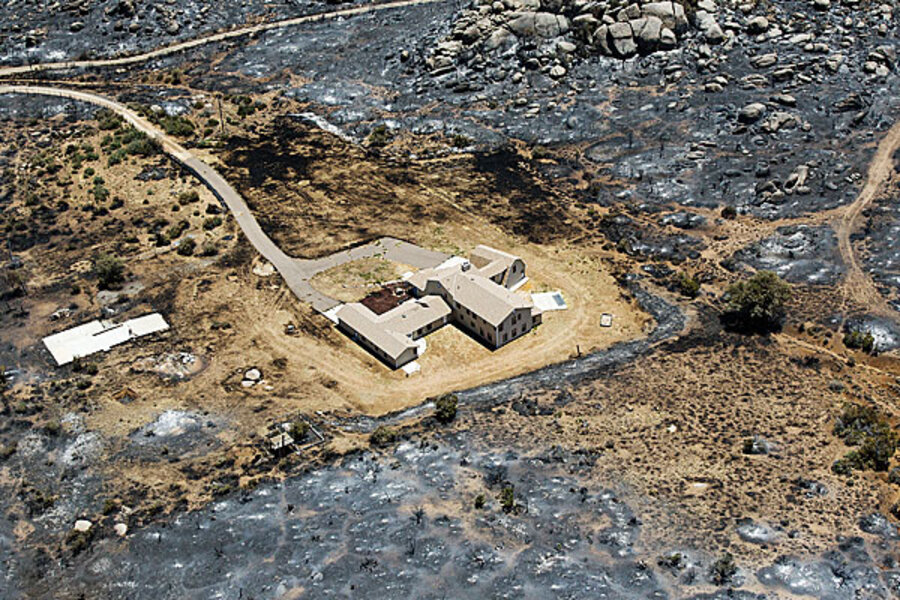Arizona wildfire prompts Congressional hearing on logging.The right focus?
Congress is going to take a hard look at wildfires next week.
Two days after the planned memorial service for the 19 firefighters killed while battling the Yarnell Hill wildfire in Arizona, on July 11 the US House Natural Resources Subcommittee on Public Lands and Environmental Regulation has scheduled a hearing on how to reduce the risk of wildfires with better forest management.
“This week, Arizona experienced the most tragic wildfire in state history when we lost 19 brave firefighters to the Yarnell Fire,” said Rep. Paul Gosar, (R) of Arizona, according to the Arizona Republic. "We owe these men our everlasting thanks and we owe their families a commitment to pursue pro-active forest management policies, which will minimize catastrophic wildfires in the future, while protecting our communities and restoring the environment. This hearing helps the committee’s efforts to achieve these goals.”
While these are worthy goals, some see this as political opportunism aimed at helping the American logging industry. In an opinion piece in the Los Angeles Times, Karin Klein criticizes the motives of the hearings:
"As yet, there is no evidence that the ferocity of the blaze that killed 19 highly trained and dedicated firefighters in Arizona was the result of a failure to thin forests by cutting down trees to create more space between those that remain, and yet already Republican congressmen are calling for hearings on “unhealthy forests" and what they see as the value of thinning...
Generally speaking, the best way to reduce damage is by thinning not in the heart of forests but along the edges closest to urban and suburban areas -- the urban interface, as it’s called -- creating what’s known as “defensible space” where firefighters can more safely and effectively carry out their heroic acts."
It is also noted that Congress has jurisdiction only over forest management on federal lands, whereas the deadly Arizona wildfire was on state and private land.
To date, the Yarnell Hill Fire, which was sparked by lightning, has burned an estimated 8,400 acres, but the total acreage has not grown for days. A spokeswoman told the Arizona Republic that 675 firefighters were still working on the blaze. As of Wednesday, the fire was 45 percent contained, up from just 8 percent on Tuesday. The Yavapai County Sheriff’s Office says that 114 of the area’s 500 homes were damaged or destroyed by the fire. Evacuated residents are expected to be able to return to the area on Saturday.
As the investigation into the deaths of the 19 firefighters gets under way, some have raised questions about whether the elite hotshots crew should have even been in the location where it was caught on Sunday.
"A team of forest managers and safety experts is charged with finding out what went wrong. In addition to examining radio logs, the fire site and weather reports, they'll also talk to the crew's sole survivor, a 21-year-old lookout who warned his fellow firefighters and friends that the wildfire was switching directions," according to the Associated Press.
One of the challenges, as The Christian Science Monitor reported, is the lack of micro-weather forecasting for fighting these kinds of fires.
"Scientists are working to turn a decade's worth of research into the interplay between fire, terrain, fuel, and weather into tools that fire managers might be able to use to try to reduce the risk firefighters face of being caught off-guard by sudden shifts in fire behavior.
Indeed, while terrain and fuel abundance play crucial roles in fire behavior, weather – including weather conditions that fires themselves foster – often is the wildcard in combating fires. It's a card that, without warning, can send thin tongues of flame lancing ahead of the main fire at speeds of up to 100 miles an hour, covering 100 yards in two seconds, only to vanish."
For some observers, the deaths of the Granite Mountain Hotshots raise a more fundamental question: Are lives being put unnecessarily in harm's way? Tim Wendel, a one-time Western firefighter, takes this position in an opinion piece in USA Today:
"If anything fighting fire has become more difficult thanks to global warming and people building trophy homes closer to the woods, sometimes right in the wilderness. These folks often have money and when their homes are threatened, the call goes out to people in Congress and others on high. The ones often told to do the dirty work (and that's what fighting fire is) are crews like one from Prescott."







